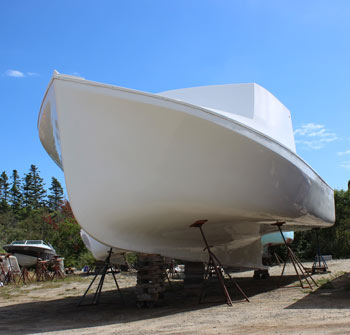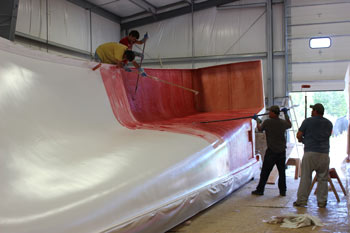Wayne Beal – Boat Building Roots and Design Future

A Wayne Beal 46' recently rolled out of the shop on its way to a finishing shop. This is a 42' hull Wayne lengthened to 46' and widened. Fishermen’s Voice photo
Jonesport has been to lobster boat building what Bath has been to ship building.
When the gasoline engine was introduced to power lobster boats, it was Jonesport’s Will Frost who took the concept and ran with it. The first gasoline engines were installed in sail-powered lobster sloops about 100 years ago. The propellers dragged the narrow wineglass-shaped aft end down. This led to a new hull design with a flatter, wider aft bottom end, square stern and a vertical skeg where the prop was mounted.
Fifty years later, wood construction was giving way to fiberglass construction. The hundreds of traditional woodworking skills in building a wood hull a piece at a time were transformed into a few large, sweeping skills in laying up a fiberglass hull. A difference between the two methods was the maintenance of traditional skills and procedures in wood construction versus the constantly changing new materials and technology in fiberglass construction.
Today most boat builders know and use the fiberglass process. But there are a few who were present at the creation, so to speak, when fiberglass lobster boat building began to take off in Maine in the 1970s.

Wetting out with polyester resin dyed red for gauging uniform coverage over the white gel coat in the mold. These skim coats will be followed by multiple structural layers of fiberglass material and resin. Fishermen’s Voice photo
Wayne Beal is a builder who learned wood boat building from the master boat builders of Jonesport and Beals. Many of those builders were his relatives and friends. He grew up working in the area’s boat shops with his brother Calvin Beal Jr., Ernest Libby Jr. and others. Beal took the skills learned in building in wood to the design and building of the wooden plug used to form the fiberglass mold in which the fiberglass hull is formed. The wooden plug, built similar to the form used to build a wood boat, is the link to the wooden ancestor of the fiberglass boat. The lines of the final glass hull are formed in the design and construction of the exterior shape of the plug.
After four years in the Navy, Wayne opened his boat building business in 1984. His first build was a mold for a 23’ hull and soon after a 34’ and then a 36’ in 1990, which, he said recently, is still a good seller. Wayne’s friend and later brother-in-law, Ernest Libby Jr., was building plugs for the Young Bros. in Corea. Wayne worked with Libby on those Young Bros. projects, one of which was a plug for their then-new 38’. Libby’s design work for Young Bros. delivered some of the record-breaking speeds on the lobster boat race courses of the 1980s and 1990s
Boats were getting bigger in the late 1980s and Wayne, along with brother Calvin, worked on a design for a new 40’. Boats have continued to get bigger and Wayne recently rolled a 46’ out of his shop, which was on its way to a finishing shop. Innovation continues in Jonesport boat building. In part it’s a response to boats going further offshore, getting bigger and the demand for bigger engines.
